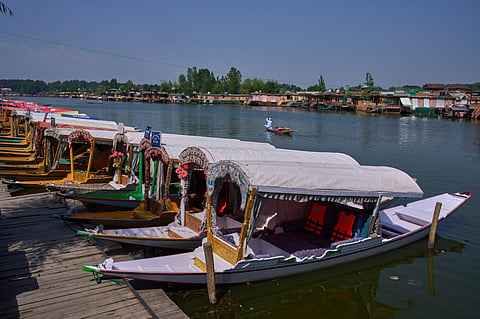Kashmir tourism bears the brunt after tourist massacre
‘There might be some arrivals, but almost negligible... almost zero footfall’

SRINAGAR: There are hardly any tourists in the scenic Himalayan region of Kashmir. Most of the hotels and ornate pinewood houseboats are empty. Resorts in the snowclad mountains have fallen silent. Hundreds of cabs are parked and idle.
It’s the fallout of last month’s gun massacre that left 26 people, mostly Hindu tourists, dead in Indian-administered Kashmir followed by tit-for-tat military strikes by India and Pakistan, bringing the nuclear-armed countries to the brink of their third war over the region.
“There might be some tourist arrivals, but it counts almost negligible. It is almost a zero footfall right now,” said Yaseen Tuman, who operates multiple houseboats in the region’s main city of Srinagar. “There is a haunting silence now.”
Tens of thousands of panicked tourists left Kashmir within days after the rare killings of tourists on April 22 at a picture-perfect meadow in southern resort town of Pahalgam.
Following the attack, authorities temporarily closed dozens of tourist resorts in the region, adding to fear and causing occupancy rates to plummet.
Graphic images, repeatedly circulated through TV channels and social media, deepened panic and anger. India blamed Pakistan for supporting the attackers, a charge Islamabad denied.
Those who had stayed put fled soon after tensions between India and Pakistan spiked. As the two countries fired missiles and drones at each other, the region witnessed mass cancellations of tourist bookings.
New Delhi and Islamabad reached a US-mediated ceasefire on May 10 but hardly any new bookings have come in, tour operators said.
Sheikh Bashir Ahmed, vice-president of the Kashmir Hotel and Restaurant Association, said at least 12,000 rooms in the region’s hundreds of hotels and guesthouses were previously booked until June. Almost all bookings have been cancelled, and tens of thousands of people associated with hotels are without jobs, he said.
“It’s a huge loss.” Ahmed said.
Ripple effect
The decline has had a ripple effect on the local economy. Handicrafts, food stalls and taxi operators have lost most of their business.
Idyllic destinations, like the resort towns of Gulmarg and Pahalgam, once a magnet for travellers, are eerily silent. Lines of colourful hand-carved boats, known as shikaras, lie deserted, mostly anchored still on Srinagar’s normally bustling Dal Lake. Tens of thousands of daily wage workers have hardly any work.
“There used to be long lines of tourists waiting for boat rides. There are none now,” said boatman Fayaz Ahmed.
Taxi driver Mohammed Irfan would take tourists for long drives to hill stations and show them grand Mughal-era gardens. “Even a half day of break was a luxury, and we would pray for it. Now, my taxi lies standstill for almost two weeks,” he said.
In recent years, the tourism sector grew substantially, making up about 7% of the region’s economy, according to official figures. Omar Abdullah, Kashmir’s top elected official, said before the attack on tourists that the government was aiming to increase tourism’s share of the economy to at least 15% in the next four to five years.
According to official data, close to 3 million tourists visited the region in 2024, a rise from 2.71 million visitors in 2023 and 2.67 million in 2022. The massive influx prompted many locals to invest in the sector, setting up family-run guesthouses, luxury hotels, and transport companies in a region with few alternatives.
Tuman, who is also a sixth-generation tour operator, said he was not too optimistic about an immediate revival as bookings for the summer were almost all cancelled.
“If all goes well, it will take at least six months for tourism to revive,” he said.
Ahmed, the hotels association official, said India and Pakistan need to resolve the dispute for the region’s prosperity. “Tourism needs peace. If (Kashmir) problem is not solved … maybe after two months, it will be again same thing.”
Sign up for the Daily Briefing
Get the latest news and updates straight to your inbox



